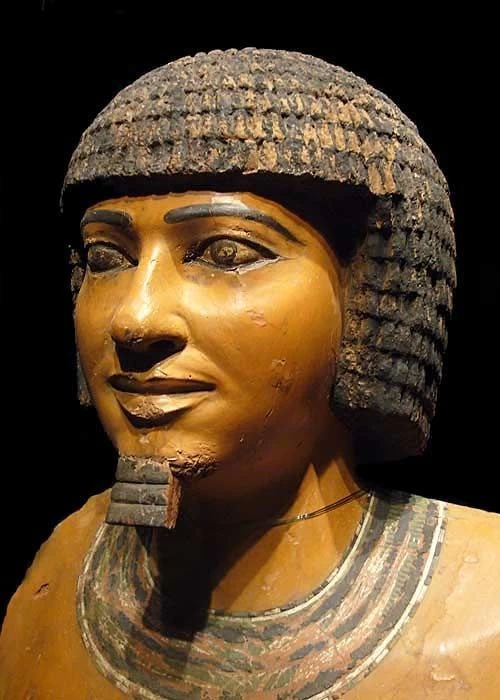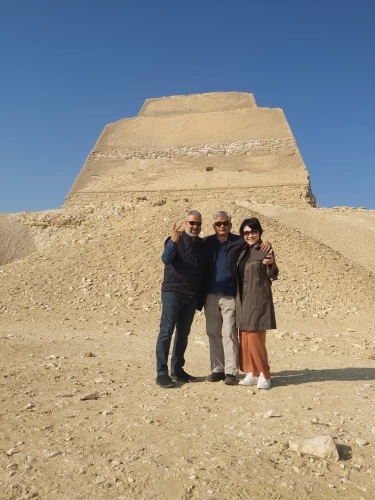
Imhetop, The First Architect
The name of Imhotep means "the one who comes in peace" and by displaying it in addition to dedicating himself, as we have seen, to medicine, he also studied astronomy, being able to develop thanks to the latter knowledge of mathematics and geometry that would serve as an architect.
Imhotep was a brilliant architect, mathematician, physician, astrologer, poet, priest, and Chief Minister to Pharaoh Djoser in ancient Egypt.
His name has endured to this day, making him the first scientist. He was not only a doctor but also a mathematician, engineer, architect, and astronomer, demonstrating that he possessed the practical understanding of geometry and arithmetic required to work in those fields.
Imhotep's main work was the funeral complex of the Step Pyramid of Saqqara, near Memphis. This construction required the extraction, transport, and modeling of literally thousands of tons of limestone, a material that until then had never been used in large constructions.
The weight of these stones was an actual nightmare that Imhotep solved using small blocks that were easy to transport and handle, creating the rectangular base of the pyramid of 140 x 118 meters, with its largest side from east to west with an original height of 60 meters.
Imhotep placed the burial chamber of King Djoser in the center, at the bottom of a well 28 meters deep and seven meters wide, built with granite and plaster, and sealed with a gigantic 3,500-kilo granite block, becoming the ideal of the Giza Pyramids and that of the other Egyptian pyramids.
His importance as a doctor lies in the fact that his teachings were copied into a papyrus in which all kinds of treatments for diseases were discussed, with pharmacological prescriptions, and although at that time medicine and magic used to mix, Imhotep was the first to try to record clinical cases, that is, without mentioning causes or magic cures, being the first to provide a rational approach to the treatment of diseases and injuries. His remedies, discovered in the so-called Edwin Smith papyrus, included the use of drugs as a stupor, and multiple anatomical observations and surgical practices were recorded as well.
In the New Kingdom, he was worshiped as the protector of scribes, representing wisdom and education. In the 'Turin Papyri' from this period, he is also described as the son of Ptah, the chief god of Memphis, in honor of his role as a wise counselor.
He is said to have extracted medicine from plants and treated diseases such as appendicitis, gout, and arthritis. At Memphis, he was served by his own priesthood and he was considered to be a mediator between men and the gods. It was believed that he could help people solve problems in their daily lives and cure medical problems.
Latest Articles
Admin
Seabourn Sojourn Cruise Stops in Safaga Port
The Seabourn Sojourn, the flagship vessel of Seabourn Cruise Line's ultra-luxury fleet, was built in 2008 at the T. Mariotti shipyard in Genoa, Italy. Measuring 198 metres, it can accommodate up to 450 guests in its 225 spacious all-suite staterooms.
Admin
Norwegian Sky Cruise Stops in Safaga Port
Norwegian Cruise Line operates a cruise ship called the Norwegian Sky. It was constructed in 1999 and can accommodate 2,004 passengers in addition to 878 crew members. The ship has several dining establishments, lounges and bars, a spa and fitness center, swimming pools, and a number of entertainment areas.
Admin
Explora II Cruise Stops in Safaga Port
Explora II, the second vessel in the Explora Journeys fleet, sets sail in 2024 to redefine luxury cruising. With 461 ocean-front suites, 9 culinary experiences, and 4 pools, this haven of sophistication and sustainability promises an unforgettable "Ocean State of Mind" journey to inspiring destinations.
Admin
Mein Schiff 6 Cruise Stops in Safaga Port
The Mein Schiff 6 is the latest cruise ship in the renowned TUI Cruises fleet, offering passengers a luxurious and sophisticated cruise experience. At 315 metres long, this floating resort features a range of dining options, entertainment, and recreational facilities, including a spa, fitness centre, and sports amenities.
Admin
Mein Schiff 4 Cruise Stops in Safaga Port
When the Mein Schiff 4 cruise ship docks in Safaga, Egypt, passengers are granted access to a realm of ancient wonders. Aboard this state-of-the-art vessel, guests can embark on meticulously curated shore excursions that showcase the region's most iconic landmarks, including the Giza Pyramids, the enigmatic Sphinx, and the remarkable tombs and temples of the Valley of the Kings in Luxor.
Admin
MS Europa Cruise Stops in Safaga Port
The Silver Moon, Silversea's latest flagship, is a luxury cruise ship that offers an exceptional travel experience for Venezuelans exploring Egypt. With a capacity of 596 guests and an impressive 40,700 gross tonnes, the Silver Moon maintains the small-ship intimacy and spacious all-suite accommodations that are the hallmarks of the Silversea brand.














